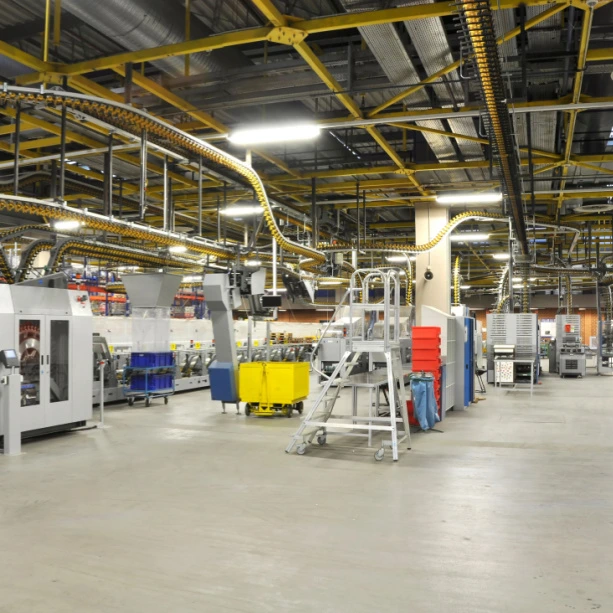Radio frequency identification (RFID) has revolutionized the way businesses operate in various industries. Used for tracking and identifying assets via radio waves, it helps these businesses stay organized and streamline their operations. This technology comes in both passive and active forms, with each operating uniquely and serving its own advantages for different use cases. WIP tracking is one such use case that provides value for manufacturing operations. But is passive RFID or active RFID better for this particular use? Let’s take a closer look.

What is WIP Tracking?
Work in process (WIP) refers to materials that have entered the production process that are not yet complete. This includes any partially completed inventory that is actively progressing through the production stages, as well as any incomplete inventory that is temporarily set aside due to material shortages, production errors, or other disruptions. If it’s not raw inventory and it’s not a completed product, then that inventory is considered work in process, no matter how far along it is or how actively it’s being processed.
WIP tracking, then, is a type of asset tracking that focuses on maintaining visibility of materials that have entered the production process that are not yet complete. It provides operators with a full picture of where in the production process any given product is, how long it has been there, and how quickly it has progressed through previous stages.
Tracking Work in Process: Why It’s Worth It
Keeping track of WIP is a massive undertaking, especially depending on the size of your company and the complexity of the products you produce. Customizable orders, which are becoming more popular to offer, make this process even more difficult. However, that does not mean you can afford to let it fall by the wayside. The consequences of forgoing WIP tracking can be devastating, leading to decreased output, loss of revenue, and decay of company reputation. As anyone in the manufacturing industry knows, these are not prospective outcomes to be taken lightly. WIP tracking helps lessen the chance of these outcomes by maintaining complete visibility of the entire production process from start to finish. It helps identify what stages of production inventory has created, the productivity rate of workers, as well as calling attention to any bottlenecks that might be indicative of a larger problem.
These benefits occur regardless of what type of WIP tracking your company utilizes. However, different WIP tracking methods do come with their own shortcomings, and some are better than others depending on the situation. The easiest way to expand upon this statement is to work through a practical example, a hypothetical scenario that some manufacturers might face. So let’s look at a few manufacturing companies that are experiencing issues with their daily operations and then examine the impact of using different types of WIP tracking to address their problem.
Increase Your ROI by Investing in AirFinder OnSite
- Low Cost. AirFinder OnSite XLE is a fraction of the cost of competitors' pricing.
- Long Battery Life. XLE lasts up to 7 years with hundreds of location updates daily.
- Increased Efficiency. Spend less time looking for assets, and more time being productive.
Scenario #1: Productivity and Production Uptime
Our hypothetical manufacturing company is struggling to maintain passable productivity levels. Production numbers are down, and it’s having a negative impact on profits. WIP fluctuates from spending far too long in production to being misplaced entirely. This is causing material components to be wasted, which is further driving up the company’s expenses. There is uncertainty as to where the issue is coming from, precisely, so it is therefore difficult to address those problems to help drive numbers back up. They need a way to understand what’s happening throughout the production process as it occurs.
Scenario #2: Raw Materials and Overprocessing
Another manufacturing company is having to order far more raw materials than their current production rate calls for, which is driving up company expenses. They’re fairly certain that this issue can be traced back to overprocessing, with individual WIP inventory re-entering production stages that they have already gone through. This has a clear effect on production output, as a single product going through a stage twice uses up time and resources that could have been used on other products. The problem is, there is not a significant enough visual difference between products that have and that have not completed the problematic stage. They need a way to keep track of what stages have already been completed by individual WIP inventory in order to prevent this from happening again in the future.
Scenario #3: Misplaced WIP Inventory
In this scenario, a manufacturing company is having problems with misplacing WIP inventory between stages. It is not uncommon for this company to experience long waits between stages, whether because a stage naturally takes a lot longer than preceding stages or because certain material components are not delivered to the plant as reliably due to persisting supply chain issues. There is designated storage for this WIP inventory, but the longer the wait is, the more difficult it becomes to recall the exact location and find it again. Also, some of the WIP inventory inevitably ends up elsewhere, whether due to improper storage or overflow of the designated area. They need a way to locate WIP inventory again once they are ready to have it re-enter the production process.
Wait, What About Manual Tracking and Spreadsheets?
Before we address the potential solutions that passive and active RFID possess for each of these scenarios, let us make one thing clear – there are manual, non-technology based methods of WIP tracking. These methods should be addressed to paint a full picture of WIP tracking and to properly contextualize the more high-tech solutions that we will be discussing in greater depth.
Yes, manual tracking and spreadsheet databases can be used to conduct WIP tracking. And for companies of a small enough scope, these solutions might even be better, as they naturally cost considerably less than formal WIP tracking solutions. However, these methods are painfully susceptible to human error and their effectiveness tends to go down as companies begin to expand, either diversifying or simply increasing their production output. The more there is to track, the more time-consuming it becomes to track WIP in this way. It also becomes more difficult to rectify record-keeping errors when there are more assets to consider. Additionally, even small scale companies can save time better used on production if they invest in an affordable WIP tracking system.
Using Passive RFID for WIP Tracking
One option for WIP tracking is passive RFID, a type of RFID that utilizes tags and readers. When the tag comes within range of the reader, the reader emits a radio frequency signal that powers the tag and allows it to transmit its data back to the reader, providing a record of the scan. Essentially, it is still a manual tracking system, but it is a manual tracking system enabled by technology. It’s easy-to-use and relatively inexpensive due to its status as a long-since established industrial technology.
How might passive RFID be used to solve our established problems? Let’s break it down one at a time.
Scenario #1: Productivity and Production Uptime
Recall, the first hypothetical manufacturing company is struggling with inconsistent production levels, including unexpected downtime and inexplicable dips in output. They’re struggling to identify where this inconsistency is coming from and need a way to maintain understanding of how their processes are working. Passive RFID is a potential solution, wherein workers are required to scan in and out WIP inventory at the beginning and end of the stages that they are responsible for. This does, however, effectively add another step to their process, albeit a momentary one. While a passable solution, it would be very easy to incorrectly scan or forget to scan inventory while in the rhythm of production; workers will need to be quite attentive.
Scenario #2: Raw Materials and Overprocessing
The second company, if you remember, is having trouble with using more raw materials than what makes sense for their output. They’re fairly certain this is due to overprocessing, but are having trouble establishing when and where this is happening. Passive RFID for this solution is functionally similar to passive RFID for productivity. By scanning WIP inventory into different stages, there is a record of whether that item has already passed through a stage, which hopefully prevents it from re-entering that stage and causing a waste of materials. It could also be used to scan raw materials in and out of storage, which could paint a better picture of how much is used and how much should be ordered. That said, it has similar shortcomings to the productivity scenario – it requires direct action on the part of workers and a certain degree of attentiveness toward that action.
Scenario #3: Misplaced WIP Inventory
The third company we are using as an example is the one that is misplacing WIP inventory between stages, making it difficult to locate after new components are obtained. For this scenario, passive RFID can be used to scan WIP inventory in and out of designated storage locations. One will recall, however, that part of the problem was that designated storage sometimes overflows and that at other times, WIP inventory is not placed in the correct storage area to begin with. In this regard, the visibility that passive RFID can find is limited, even before accounting for the usual issues that come with human error.
Using Active RFID for WIP Tracking
Another option is active RFID. Unlike passive RFID, active RFID is truly automated. Active RFID tags have a battery-powered transmitter that emits a signal at regular intervals. When the tag comes within range of an RFID reader, the reader automatically detects the signal and records the location and status of the tag. Most importantly, active RFID tags can transmit signals over longer distances than passive RFID tags, meaning that they do not require hand scanners as part of their function. This is how it can eliminate the manual component and embrace full automation.
Let’s look at our hypothetical scenarios again, this time with regards to how active RFID would solve the problems and enable WIP tracking use cases.
Scenario #1: Productivity and Production Uptime
In solving the challenge of unpredictable and inconsistent production output with passive RFID, there came the problem of the human element. After all, passive RFID requires manual scanning and essentially adds another step to a worker’s process. With active RFID, there is no added step after setup. Instead, a signal is automatically transmitted to indicate movement, which can include movement through a process with consideration to designated work zones.
Scenario #2: Raw Materials and Overprocessing
As for the hypothetical company struggling with overuse of raw materials and suspected overprocessing, the use of active RFID is much the same. Once again eliminating the troublesome manual element, active RFID can track the product throughout the process. With the use of historic data, workers will be able to easily identify which production stages an individual piece of inventory has undergone. This will help reduce instances of overprocessing and material waste. It can also provide the same benefits as passive RFID in informing operators on the true rate of material usage, which can help guide purchasing decisions.
Scenario #3: Misplaced WIP Inventory
Recall the final scenario, and the issue with passive RFID to address the challenge of misplaced WIP inventory. As long as inventory is restricted to a designated area, passive RFID can be used to scan it in and out. But the problem is that misplaced WIP is often misplaced precisely because it is not returned to its designated location. For this challenge, passive RFID cannot offer a direct solution. Active RFID, on the other hand, can span across an entire facility. No matter where WIP inventory is placed, so long as it is properly tagged and the campus infrastructure is set up properly, an active RFID system should be able to display the missing inventory’s location so that it can be retrieved.
Passive RFID or Active RFID: Which is Better?
Now, let’s return to the question we started with: is passive RFID or active RFID better for WIP tracking?
By examining our hypothetical companies, it is readily apparent that based on function alone, active RFID simply has more to offer when it comes to WIP tracking. It fully eliminates the element of human error that haunts both spreadsheet tracking and tracking with passive RFID. It also has the potential to locate misplaced inventory where passive RFID simply cannot. Further, active RFID systems tend to last longer, as their components aren’t as frequently handled as their passive RFID counterparts. Handheld scanners, after all, are hardly stationary. And technology that doesn’t stay in one place is far accident prone.
Does that mean passive RFID has no value? Certainly not. For smaller companies that want to improve their WIP tracking but have limited budget, passive RFID can provide a relatively cheap first step into the world of industrial technology. It is still a powerful tool for WIP tracking, even if it fails to obtain the ideal of truly automated real-time visibility.
Affordable Asset Tracking with Link Labs
Link Labs provides an asset tracking system that provides complete, automated visibility of your production process. Not only that, but our WIP tracking solution is customizable to your needs, providing an affordable option for real-time tracking that your company might not have been able to afford otherwise. For all the benefits of active RFID at a fraction of the anticipated investment cost, reach out and book a demo today!





